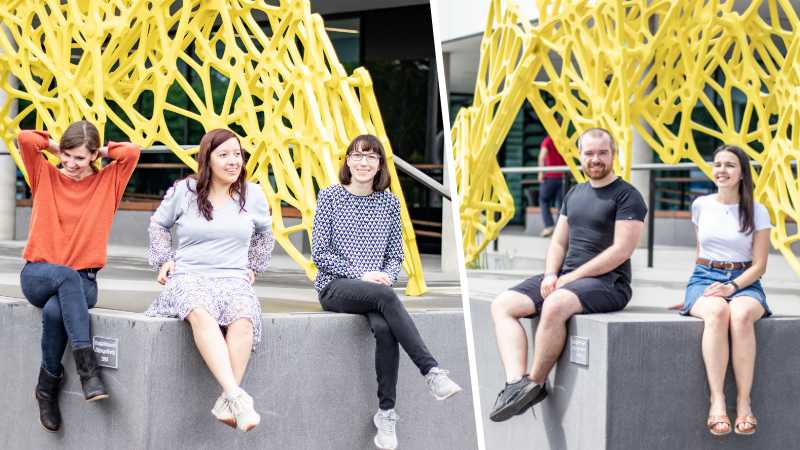Five of sixteen nominated DIGS-BB PhD students received the DIGS-BB Fellow Award 2021:
- Lizbeth Airais Bolaños Castro (Maximina Yun Group)
- Laura Meißner (Stefan Diez Group)
- Liliya Mukhametzyanova (Frank Buchholz Group)
- Theresa Schütze (Mareike Albert Group)
- Martin Striegler (Stefan Diez Group)
The award honours outstanding PhD students after the 1st year of thesis work and includes a price money of €2,000. It aims to help their research work, development of research skills, and to strengthen their research network. The allowance can be used to cover project consumables, attendance to workshops and conferences, research visits to collaborators’ labs, as well as to cover cost for a side project.
An outstanding performance during the 1st year of PhD work, along with a nomination and justification by their Thesis Advisory Committee (TAC) in the 1st AR TAC meeting is required to be eligible for the award. The students presented the current state of their thesis work to the DIGS-BB Steering Committee in writing and in a talk. Detailed information on that work can be found below.
Lizbeth Airais Bolaños Castro
“I am developing my thesis project at the Yun lab, where we aim to unravel roles of the immune system during regeneration processes using salamanders as our models. Salamanders can regenerate complex structures such as limbs, tail and different internal organs, and in the context of regeneration, different immune cellular players are of interest due to their capacity for tissue infiltration and cytokine supply. Thus far, evidence across different organisms ranging from fish to mammals has shown that immunity plays essential roles during regeneration and wound healing, with most research focused on the roles of macrophages, members of the innate immune system. Nevertheless, regarding adaptive immunity little is known in salamanders. Hence, in this project we aim to bridge this knowledge gap by describing the potential roles of adaptive immunity during salamander limb regeneration. By exploring the physiology of adaptive immunity in salamanders in this context, we overall aim to contribute to a better understanding of their amazing regeneration capabilities.”
Laura Meißner
“I am decoding how molecular motors orchestrate the complex process of cell division. When cells divide, spindle fibers attach to chromosomes to distribute them to the new cells. Molecular motors, specifically kinesins, move and push these fibers, which are microtubules. But how do they perform this task? To address this question, I am investigating the motion of the motors along, in which they rotate around microtubules. Additionally, I am measuring the forces they generate in the rotation. For this purpose, I am using in vitro motility assays with fluorescence microscopy, optical tweezers, and theoretical modelling. My aim is to gain insights into the functioning of the motors and shed light on their role in spindle organization.”
Liliya Mukhametzyanova
“Evolved Cre-like recombinases are a new genome engineering tool with a precise DNA alteration mechanism which makes them great candidates for clinical application. In my PhD project, I use protein engineering to develop techniques that allow to improve target specificity of the evolved recombinases, in order to expand their utility for therapeutic genome editing.”
Theresa Schütze
“The largest structure of the human brain, the neocortex, has increased drastically in size throughout primate evolution - the human cortex is almost three times the size that of the chimpanzee. Mechanistically increased size is achieved through divergent developmental programs, including an increase in proliferative potential of neural stem and progenitor cells. While genes provide the basic information for these cells’ behavior, complex gene expression patterns are regulated by another layer of information - the epigenome. In my project I study how factors other than genes contributed to primate cortical evolution. Using cortical organoids as a model system, I study neural stem and progenitor cell type-specific gene regulation in macaque, orangutan, chimpanzee and human neural development. With my project we hope to advance our understanding of the epigenomic code of brain development in humans and other primates as well as its evolutionary history.”
Martin Striegler
“From the movement of sperm cells to the clearance of lungs, motile cilia are key to fundamental biological processes. Inside cilia, the cytoskeletal core called the axoneme generates this movement. Tens of thousands of dynein motor proteins cooperatively act forces on the structure of the axoneme. To generate movement, dynein activity must be regulated precisely over time and space. After more than 60 years of research in this field, it is still unknown how dynein activity is regulated. A recent theoretical study on 3D axonemal geometry hypothesized a geometrical feature that can solve the riddle – Axonemal Twist. In my thesis, I aim to experimentally test this hypothesis. My goal is to resolve the axonemal geometry with nanometer precision and micro-second resolution by combining structural and functional investigation.”
